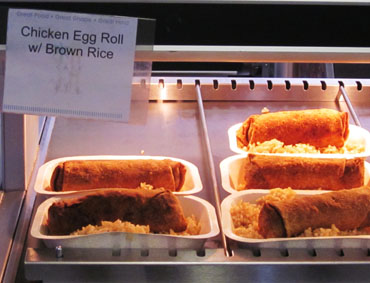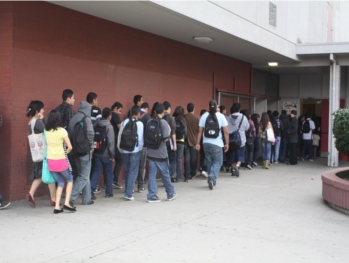 When the 1 p.m. bell rang at Manual Arts High School, the students fled to the cafeteria for lunch. As the line lengthened, students carried small Styrofoam trays toward shelves of food.
When the 1 p.m. bell rang at Manual Arts High School, the students fled to the cafeteria for lunch. As the line lengthened, students carried small Styrofoam trays toward shelves of food.
That day, they could choose from baby carrots with dip, celery with dip, oranges, cheese ravioli with sauce and a whole wheat dinner roll, an Italian calzone with turkey pepperoni, chicken egg roll with brown rice, and non-fat regular milk, chocolate, or strawberry.
“A student must take at least three of the items that are offered,” said Susan Hernandez, the cafeteria manager at Manual Arts.
And at best, many of the students do grab onto at least three of the items offered because it’s free food.
Located in South Los Angeles, Manual Arts High School is a Provision 2 school under the Federal School Lunch Program, said Hernandez. Its Provision 2 status means it qualifies for all meals to be served for free due to the overall demographics of the school. Roughly 80 percent of Los Angeles Unified School District students are eligible for free and reduced price meals, according to the district.
Although some students, like Kevin Soto, said they would rather bring a packed lunch from home, they still take the cafeteria food because it’s free.
“Most of the cafeteria food is nasty,” said Soto. “When it comes to lunch, we’ll only eat two things…Sometimes I just get [the lunch] because of the milk.”
Building the Menu
In the past few years, L.A. Unified has been working toward supplying healthy options for students and also encouraging more students to eat cafeteria lunches.
 In 2004, the school board passed the Childhood Obesity Prevention Motion; in 2005, it launched the Cafeteria Reform Motion. Both motions set strict guidelines on what kind of food can be served in schools based on calorie count. They also reduce levels of sugar, sodium, and saturated fat and eliminating trans fat and palm oil in menu items and junk food and soda sales.
In 2004, the school board passed the Childhood Obesity Prevention Motion; in 2005, it launched the Cafeteria Reform Motion. Both motions set strict guidelines on what kind of food can be served in schools based on calorie count. They also reduce levels of sugar, sodium, and saturated fat and eliminating trans fat and palm oil in menu items and junk food and soda sales.
The Cafeteria Reform Motion put together a cafeteria improvement committee and a sub-committee that is made up of district employees and external participants including dieticians, obesity researchers, registered chefs, and healthy food advocacy groups, according to David Binkle, the deputy director of L.A. Unified Food Services.
The menu is determined by first looking at United States Department of Agriculture (USDA) guidelines. No more than 30 percent of a meal’s calories can come from fat, and the meal also must provide one-third of the recommended dietary allowances of protein, Vitamin A, Vitamin C, iron, calcium and calories, according to the USDA website.
Meals cannot exceed 1100 milligrams of sodium over a week’s period of time, and grain that is served must be 51 percent whole wheat, said Binkle. L.A. Unified is currently operating under 2005 dietary guidelines.
Money for the food comes from the federal and state government. Last year, the district served around 123 meals that fall under the nutrition criteria, which it did on an average of 77 cents per meal.
Currently, the district is working on adopting a new menu to test with students. Once the draft menu is finalized, all items will have to get approved by at least 30,000 students. The final menu will not be approved until two weeks before the 2011-2012 academic year starts.
 Healthier Food, Healthier Students
Healthier Food, Healthier Students
Organizations like the Healthy School Food Coalition, which reaches out to schools and parents to get them involved in the menu-making process, have responded to the efforts to improve nutrition, especially because the menu affects many low-income students in the inner city.
Elizabeth Medrano, who works as the school food organizer for the coalition, applauded the district’s reduction of cheese and bread in its meals.
Although strides have been made to create healthier options for students, the total body mass index (BMI) for L.A. Unified students is on the rise.
BMI, a way to measure obesity, is an estimate based on one’s height and weight. The BMI of students in the L.A. Unified has risen from 24.4 in 2003 to 26.1 in 2010, as opposed to the BMI rates of the total population of Los Angeles County, which have fluctuated between 21.9 and 23.1. According to the U.S. Department of Health, a BMI ranging from 25.0 to 29.9 is overweight, and a BMI of 30 or greater is obese.
Binkle said that this high rate, however, does not correlate to the nutritional value of the menu but rather how much physical activity the students engage in to burn the calories they eat. A 2008 obesity report by the Los Angeles Department of Public Health attributed the stabilization of L.A. Unified’s students’ BMI to changes made in the nutrition arena.
Got Chocolate Milk?
But one group of activists, who have attended many of the menu planning sub-committees, believes that there is a way that the meals are contributing to a child’s obesity. On Feb. 14, Emily Ventura, who is a researcher at the Childhood Obesity Research Center at the University of Southern California, gathered a group of parents and left one-gallon jugs of sugar at district headquarters to advocate for flavored milk to be taken off the cafeteria menu.
 Ventura said that each cartoon of chocolate milk has two teaspoons of sugar. If a student drank two cartoons every school day, the student would consume 14 cups or roughly a gallon of pure sugar.
Ventura said that each cartoon of chocolate milk has two teaspoons of sugar. If a student drank two cartoons every school day, the student would consume 14 cups or roughly a gallon of pure sugar.
“[The district] is afraid of taking sugar out because they are afraid the kids won’t drink the milk,” Ventura said.
Binkle responded that the amount of added grams of sugar in chocolate milk—at seven grams—is the equivalent of a piece of fruit.
Ventura sees a pitfall in the cafeteria nutritional guidelines because they don’t count overall added sugar content. She mentioned that 1 in 3 kids born in the year 2000 are projected to develop diabetes in their lifetime, and this estimate is higher for Latino kids (1 in 2, or 50 percent), according to study done by the National Center for Chronic Disease Prevention and Health Promotion in 2008.
Moreover, Ventura’s published research, conducted in a 16-week time period, analyzed if reduced sugar intake or increased fiber intake of 54 overweight Latino teenagers contributed to the development of type II diabetes. The published article states that almost 40 percent of Latinos ages 12-19 were overweight or at risk of becoming overweight between the years of 2003-2006. The subjects who increased fiber intake decreased significantly in BMI. Adolescents who simply decrease the amount of added sugar in one can of soda can and increase fiber intake equal to a half a cup of beans may see positive results that can stabilize their metabolism and reduce their risk of developing type II diabetes.
She also said that I made it sound like her chocolate milk campaign was linked to USC, so she asked if I could add that it she volunteers as the Social Action Chairperson of Slow Food Los Angeles.
The current policies of the USDA don’t look at the overall sugar content of a meal except that there can only be seven grams of added sugar in an ounce of cereal, said Ventura. She believes that they are not proactive enough if Frosted Flakes and Frosted Wheaties still make the cut.
Yet, Ventura did admit to some positive changes made at the district level.
“Looking at the menus that the committee has been proposing, I’m seeing that there are some positive changes like the coffee cake is served less often,” she said.
Only a handful of people, like Ventura, have raised awareness about the total content of added sugars in the meals during the three years Binkle has served as deputy director of food services. Binkle said that a few speaking out against overall sugar count may not correlate in change.
“We’ve had chocolate milk in this country for 100 years, what happened to those kids?” Binkle said. “It’s about exercise and taking your time to eat properly.”
Related Stories:
Experts discuss the ‘politics of food’ in South L.A.
Basketball players teach healthy living at local elementary school









 By Susana Valencia
By Susana Valencia




